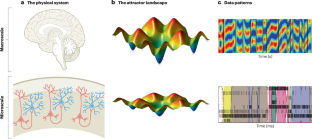亚稳态去神秘化-基础的过去,务实的现在和充满希望的未来
IF 28.7
1区 医学
Q1 NEUROSCIENCES
引用次数: 0
摘要
健康的大脑功能有赖于平衡脑区之间的稳定整合,以实现有效的协调功能,同时也有赖于共存的分离,允许子系统表达其功能特化。动态系统文献中的一个概念 "可转移性"(Metastability)被认为是这种平衡的一个关键特征。在这一原理的基础上,神经科学文献利用可转移性现象研究了健康和疾病中大脑功能的各个方面。然而,这些研究成果往往只是启发式地使用了 "可迁移性 "这一概念,有时甚至使用得并不准确,这使得我们很难在浩如烟海的文献中游刃有余地解读研究结果,并促进理论和实验方法的进一步发展。在此,我们将全面回顾可迁移性及其在神经科学中的应用,包括其科学和历史基础,以及在经验数据中用于评估可迁移性的实用方法。我们还对最近的理论发展进行了批判性分析,澄清了常见的误解,并为未来的发展铺平了道路。本文章由计算机程序翻译,如有差异,请以英文原文为准。


Metastability demystified — the foundational past, the pragmatic present and the promising future
Healthy brain function depends on balancing stable integration between brain areas for effective coordinated functioning, with coexisting segregation that allows subsystems to express their functional specialization. Metastability, a concept from the dynamical systems literature, has been proposed as a key signature that characterizes this balance. Building on this principle, the neuroscience literature has leveraged the phenomenon of metastability to investigate various aspects of brain function in health and disease. However, this body of work often uses the notion of metastability heuristically, and sometimes inaccurately, making it difficult to navigate the vast literature, interpret findings and foster further development of theoretical and experimental methodologies. Here, we provide a comprehensive review of metastability and its applications in neuroscience, covering its scientific and historical foundations and the practical measures used to assess it in empirical data. We also provide a critical analysis of recent theoretical developments, clarifying common misconceptions and paving the road for future developments. Metastability is a concept from dynamical systems. In the brain, it is thought to reflect the balance between the cooperative and independent functioning of brain areas or neuronal populations. In this Review, Hancock, Rosas and colleagues provide an overview of metastability in neuroscience.
求助全文
通过发布文献求助,成功后即可免费获取论文全文。
去求助
来源期刊

Nature Reviews Neuroscience
NEUROSCIENCES-
自引率
0.60%
发文量
104
期刊介绍:
Nature Reviews Neuroscience is a multidisciplinary journal that covers various fields within neuroscience, aiming to offer a comprehensive understanding of the structure and function of the central nervous system. Advances in molecular, developmental, and cognitive neuroscience, facilitated by powerful experimental techniques and theoretical approaches, have made enduring neurobiological questions more accessible. Nature Reviews Neuroscience serves as a reliable and accessible resource, addressing the breadth and depth of modern neuroscience. It acts as an authoritative and engaging reference for scientists interested in all aspects of neuroscience.
 求助内容:
求助内容: 应助结果提醒方式:
应助结果提醒方式:


